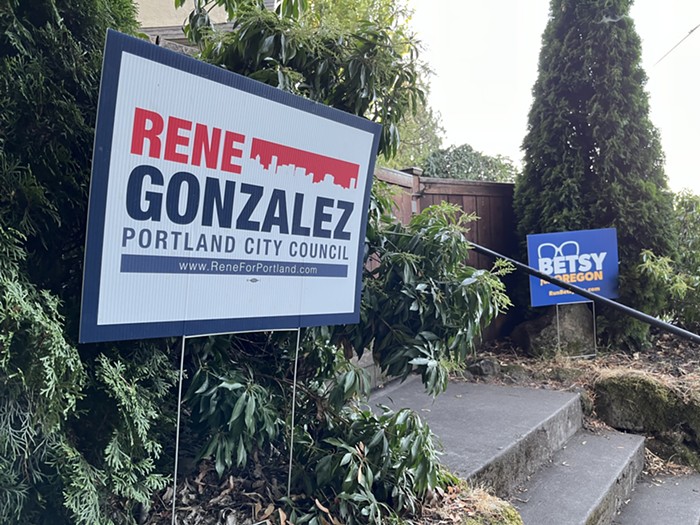
Videogames
IT'S A TESTAMENT to Disjecta Curator-in-Residence Rachel Adams' range that this fall's Intimate Horizons is followed by Sightings, a collection of video installations from Jessica Mallios and Kevin Cooley. While Intimate Horizons featured Claire Ashley's colorful, balloon-like, almost humanoid objects, Mallios and Cooley's video installations challenge what we ordinarily expect from video art and photography, the works' pointed coolness the polar opposite of larger-than-life sculpture.
Named for San Antonio's 750-foot rotating observation tower slash restaurant (where it was filmed), Mallios' "Tower of the Americas" is an ode to Steadicam. Her camera remains static while the tower circles, providing a disorienting look at the city. But the camera's real focus is the smudges, scratches, and raindrops on the glass in between the camera and its subject, writ giant in the camera's focus, like imperfections blown up hugely on a filmstrip—in effect, the Tower's window becomes a smudged lens, captured through a clean one.
Photography is a medium historically well suited to hiding your tracks: Even pre-Photoshop, when an image emerged interrupted by dust spots and scratches, the painstaking next step would be to fill them in with exactly the right shade of dark ink. So to see a video in which imperfections aren't a distraction but the subject—especially of something this precisely made—is destabilizing and unexpected.
But it's Cooley's "Skyward" that truly stands out—at first, it just looks like a nubby patch of fake turf strewn with pillows, out of place and almost sloppy-looking in the middle of the pristine gallery floor. Lie down on the "grass," though, and you'll see a video projected onto the ceiling, the camera face-up and moving lazily through Los Angeles, capturing the underbelly of a freeway overpass, vapor trails from planes overhead, the edges of buildings, and palm trees shaking against a perfectly blue sky. Disjecta's curatorial materials state that Cooley's intent was to replicate the perspective of a passenger looking up from a convertible, and I can see it, minus the infuriating Celtic knot of LA traffic.
If Adams' Intimate Horizons-to-Sightings quick-change is any indication, it'll be interesting to see what she does next.

Money, Cash, Woes
EMILY HANNA WYANT takes the subtle whimsy of Cooley's fake grass lawn, and amplifies it with the unapologetic weirdness of a nascent Fischli and/or Weiss. In Gotta Make Money to Make Money, up now at Nisus Gallery, Wyant set her sights on perceptions of value, whether in a retail or gallery environment (or both—this is a show that strongly critiques the commercialization of art via the gallery system). Wyant's centerpiece is a stack of 239 handmade gold bricks. They aren't real gold, obviously—the truth is right there in the piece's title ("Counterfeit Gold Bricks") and the materials listed (plaster and gold spray paint). But that doesn't really matter, and in fact it's kind of the point. If anything, Gotta Make Money embodies the transfigurative power of the art world: Almost anything can be called art, and once it achieves that designation through the accepted channels, it takes on a type of cultural and financial value, whether earned or not.
Joining the bricks: lightboxes housing lyrics from Wu-Tang Clan and Nicki Minaj. While seeing "Cash rules everything around me." on a lightbox in a gallery is an experience I'd wish on anyone, I wonder if Wyant would've packed even more of a punch had she only offered up that stack of meaningless gold bricks, in all of its slapdash, fuck-you glory.













